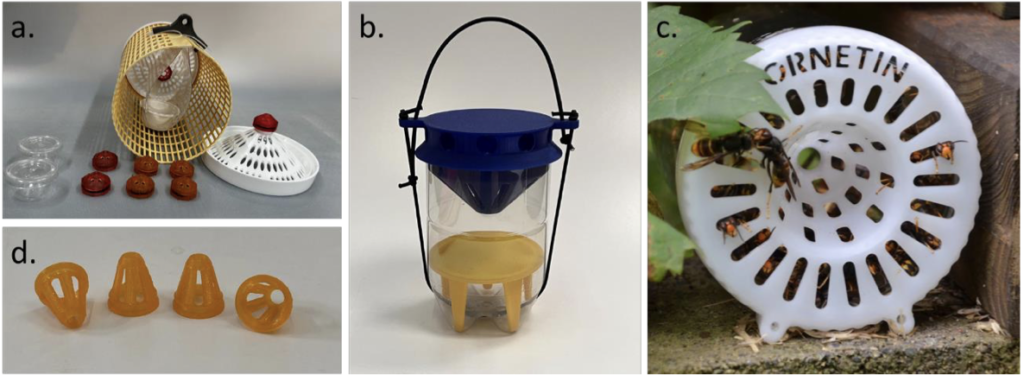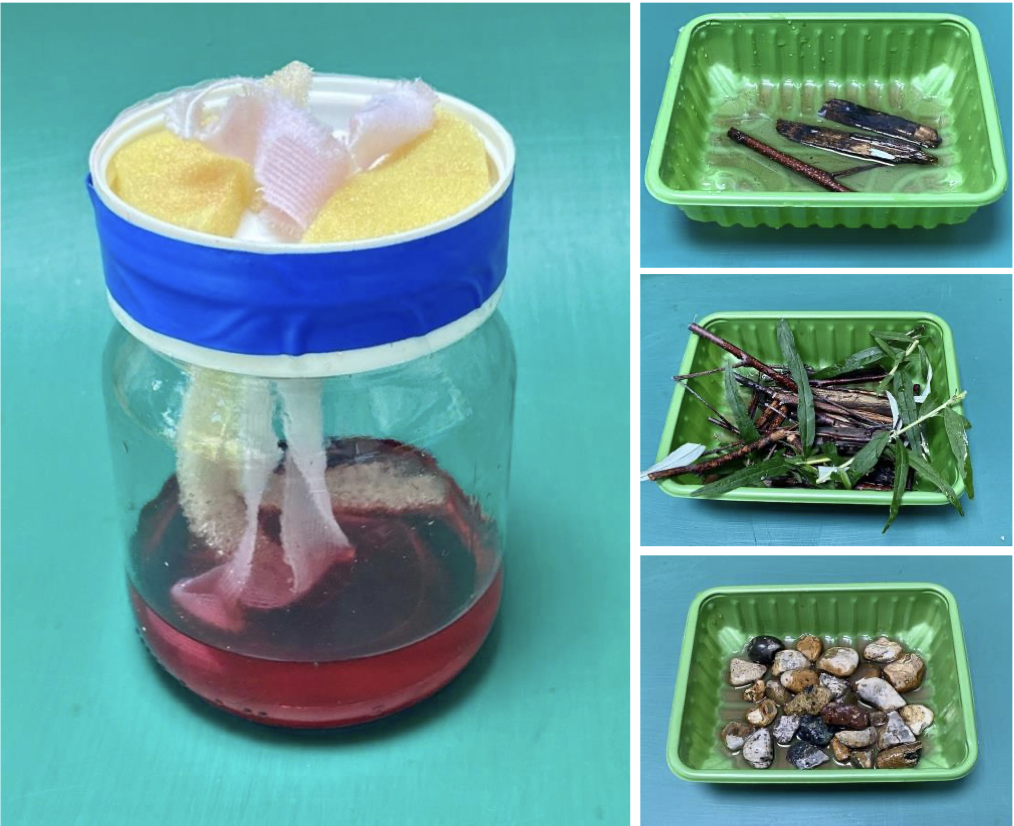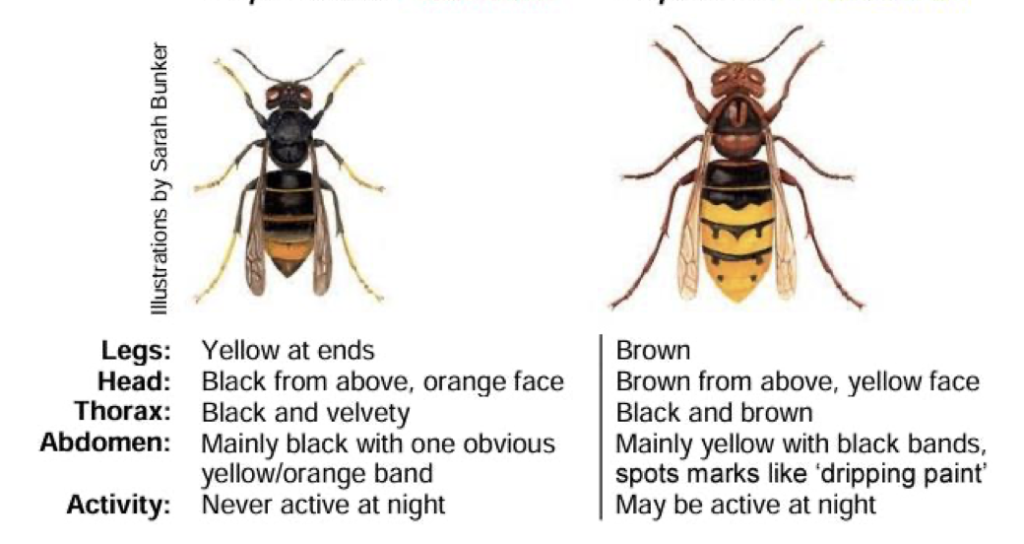Advice from the National Bee Unit. September 2024
Monitoring the environment for foraging hornets allows us to identify if a yellow-legged hornet nest may be present in an area. Frequent and widespread monitoring is needed throughout the UK to manage yellow-legged hornet incursions. Members of the public can significantly contribute by monitoring for foraging hornets, and reporting yellow-legged hornet sightings. This fact sheet outlines the process for monitoring yellow-legged hornet activity, whilst minimising the impact on native invertebrates, and for reporting suspected yellow-legged hornets.
The yellow-legged hornet
The yellow-legged hornet, a.k.a. the Asian hornet (Vespa velutina nigrithorax), is an invasive, non-native hornet that predates on invertebrates. The species was accidentally introduced into France, from Asia, in 2004 and has now spread into Spain, Majorca, Portugal, Italy, Belgium, Germany and Switzerland. The hornet was found for the first time in the UK in September 2016,with a single nest discovered. A small number of nests were discovered and destroyed in each of the subsequent years, however, in 2023, 72 nests were found. There is a high risk of this species becoming established in the UK, and it will take intensive effort to limit the speed of spread. To this end, widespread monitoring is crucial and we strongly encourage beekeepers and members of the public to monitor for the presence of foraging yellow-legged hornets in their area and report suspected sightings.
Methods of monitoring
Hornet foraging activity can be monitored through the use of traps or monitoring stations. Traps are composed of an enclosure with a bait for attracting yellow-legged hornets. As the bait will also attract other invertebrates, traps should only be used if they have the means to allow non- target invertebrates to escape, and to prevent entry of the larger, native European hornet, Vespa crabro. As some beneficial insect populations in the UK are in decline, we strongly urge that only traps that do not harm non-target invertebrates are used.
Monitoring stations are composed of an open tray or container with a bait, or a closed jar or container with a bait, and a wick. This allows invertebrates and yellow-legged hornets, if present, to visit the station to feed and fly away. It has the benefit that non-target insects are not harmed, and the trajectory of the hornet’s return to its nest can be determined. Monitoring stations are used by NBU Inspectors during active surveillance for yellow-legged hornets. The disadvantage is that they require active monitoring.
Monitoring traps
Traps can be home made, or purchased from various retailers. It is important to use traps that have been designed with openings of different sizes. This allows entry of invertebrates the size of the yellow-legged hornet or smaller, thereby preventing entry of large native hornets; but with escape apertures small enough to allow the smaller, non-target invertebrates to escape once inside; but too small for the yellow-legged hornet to escape. The commercially available traps vary in how selective they are at catching yellow-legged hornets. It is important to note that yellow-legged hornet queens are larger and wider than workers; queens are up to 30 mm long, but workers are up to 25 mm. Here we mention a small number of non-lethal, selective traps that have been used in the field by National Bee Unit (NBU) Inspectors.
The Gard’Apis trap (Fig 1a) is a selective and non-lethal trap that comes with two different nozzles; one (in red) for catching yellow-legged hornet queens in spring and the other (in orange) which is narrower, and used for catching workers from May onwards. Both nozzles prevent European hornets from being accidentally captured, and the mesh on the sides of the trap allow smaller insects to escape. A small dish inside is used to hold the bait.
The Asian hornet trap (blue/yellow) by Andermatt (Fig 1b) is a selective, non-lethal trap for yellow-legged hornet monitoring. The trap has 8 mm entrance holes that are large enough to allow the yellow-legged hornet, and any smaller invertebrates, into the trap. However, the entrance also has a 5 mm groove which allows the smaller invertebrates to escape. A yellow platform placed above the bait prevents the inhabitants from drowning, and makes the trap non-lethal.
The Ornetin Asian hornet trap (Fig 1c) is designed as a lid that screws onto a 100 mm diameter jar (not supplied). The lid is screwed onto the jar, which is placed on its side with a small bundle of straw or cotton soaked with bait, but not so much that liquid pools in the trap. The lid has holes large enough to allow the smaller invertebrates to escape, while keeping yellow-legged hornets trapped.

Figure 1: A small number of commercially available selective traps. A. The Gard’Apis trap (Image courtesy of Gard’Apis), B. the Asian hornet trap (blue/yellow) (Image courtesy of Andermatt), C. The Ornetin trap (Image courtesy of Ornetin) and D. pre-made trap ferrules (Image courtesy of Andermatt).
This fact sheet is not an endorsement of any one product over another and these products have not been tested by the NBU. Other traps are available from other manufacturers and trap design is evolving all the time.Please avoid use of lethal traps, without modification, as they may harm native invertebrates, and sticky/glue traps, which may harm birds. Please monitor traps regularly, especially when testing a new trap, to ensure that non-targets can escape, and if they cannot, release them, and check to ensure that traps haven’t filled the rainwater, potentially drowning the occupants.
If you wish to construct your own trap, there are pre-made trap openings called ‘ferrules’ (Fig 1d) that can be purchased and installed in home made traps. Alternatively, there are many patterns for 3D printing. Use of these will help prevent the capture of non-target invertebrates. Home made traps should also contain a platform or wick, to prevent invertebrates from drowning in the bait.
Monitoring stations
To set up a monitoring station, place a dish or container in a sunny, visible location with a small amount of bait or attractant on it. If necessary, place a wick or some straw over the bait so that invertebrates do not drown in it. Check the monitoring station at regular intervals throughout the day. Please note that while it is not legal for members of the public to capture and release yellow- legged hornets, monitoring their foraging activity is permitted.
Monitoring using a monitoring station is unlikely to be informative in spring, when only queen hornets are likely to be foraging; chances of encountering one with this method are low, so monitoring traps are preferred. Monitoring stations are more appropriate for use in the mid-season, especially during August, when hornet foraging will be at its peak. NBU Inspectors use monitoring stations when hornets are known to be in the area. They use the stations to visually monitor for foraging hornets, and observe the trajectory of the hornets after feeding, as they return to their nest. In this way, they have been successful at tracking and tracing hornet nests.
We recommend the use of monitoring stations when hornets have been reported in the surrounding area. When observing the monitoring stations, it will be helpful to have a camera nearby to photograph any suspect hornets.

Figure 2: A small selection of possible monitoring station designs. Image courtesy Ian Nichols, Crown copyright 2024.
Where should I monitor?
The yellow-legged hornet could arrive anywhere in the UK. Monitoring is especially important if you live close to a ‘risk point’ such as a ferry terminal or port, and in regions where hornet nests have been discovered in previous years. We would encourage everyone in high-risk areas to monitor regularly, especially if there is an alert from the NBU and BBKA warning of a nearby incursion. There is no need for spring monitoring in areas that are not at high risk.
Monitoring stations and traps are best placed in sunny areas; in trees, on hive stands, in and around affected apiaries, and at head height. Avoid placing them in shaded areas, as hornets are less likely to forage there.
When should I monitor?
Yellow-legged hornet queens emerge in early spring, traps for queen trapping can be placed from March until May. For spring monitoring, traps are more appropriate than monitoring stations. Yellow-legged hornet workers forage throughout the beekeeping season, so monitoring should continue from spring until autumn. For post-spring monitoring, traps or monitoring stations can be used.
Which bait should I use?
Sweet baits are highly attractive to foraging yellow-legged hornet queens in early spring. This is because queens emerging from hibernation need high-energy, sweet foods. There are many variations of home made sugar baits, these include mixes of sugar and various types of dark beer, alcohol or fruit juice.
During the summer, at the height of the beekeeping season, worker hornets forage for protein sources to feed the larvae. To make a protein bait, raw meat or fish with water can be used. The
NBU have used protein baits consisting of mashed fish or prawns, diluted to 25% in water. If you choose to use a protein bait, it will need changing after 3 days due to decay and an unpleasant aroma. yellow-legged hornets have been discovered feeding on windfall and ripe fruit; this can also be used as bait later in the season.
NBU Inspectors use a commercially available wasp bait called Trappit (suterra) for track and trace. It is a sweet bait that contains a bee deterrent, and can be used throughout the year, as hornets always need to feed on sugars for energy. Other wasp baits are available.
How do I empty monitoring traps?
Release all other live, native insects to preserve as many non-target species as possible. Traps should be visited and emptied regularly; ideally daily. It is very important not to harm native invertebrates.
Please take care when releasing insects if stinging insects are present in the trap. Hornets and wasps can sting and can cause a severe reaction. Most insects are not naturally aggressive but can be defensive when trapped. If you are concerned about releasing stinging insects, the traps can be chilled down in a fridge for about 30 minutes or until they slow down. Empty the trap somewhere warm and dry outside, and the insects will eventually wake up and fly away.
If you think you have caught a yellow-legged hornet, you can place the whole trap, unopened, in a sealed freezer bag. Place the bag containing the trap into a freezer for 12 hours before opening, to avoid being stung or losing your suspect specimen. Alternatively, traps can be placed into a bucket of soapy water for an hour so that the hornet can be safely sieved out.
How do I know if I have caught a yellow-legged hornet?
There are thousands of misidentifications in reports for yellow-legged hornet every year. These reports can be time-consuming to follow up. We would therefore request, before submitting a report, that all individuals familiarise themselves with what the yellow-legged hornet looks like, and how to differentiate it from native invertebrate species. Full guidance on identification can be found in the Asian hornet identification sheet.

How do I report sightings and captures?
Alert the National Bee Unit of your suspect sighting as soon as possible using the ‘Asian Hornet Watch’ iPhone or Android app or by filling out an online report form.
It is important to note the location as accurately as possible and obtain a photograph, to allow experts to confirm identification of your sighting.
National Bee Unit
APHA, Room 11G03, York Biotech Campus,
Sand Hutton, York, YO41 1LZ.
Telephone: 0300 303 0094
Email: nbu@apha.gov.uk
Web site: www.nationalbeeunit.com
For a copy of the source leaflet go to https://www.nationalbeeunit.com/assets/PDFs/3_Resources_for_beekeepers/Fact_Sheets/Fact_01_Asian_Hornet_Monitoring.pdf
September 2024
© Crown copyright 2024
You may re-use this information (excluding logos) free of charge in any format or medium, under the terms of the Open Government Licence v.3. To view this licence visit
www.nationalarchives.gov.uk/doc/open-government-licence/version/3/ or email PSI@nationalarchives.gsi.gov.uk